LEGO box variations by country: part 2, 1972-92
Posted by Huw,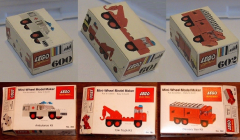
Gary Istok continues his article on box variations:
In the first part of this series the discussion was about LEGO sets in the 1950s that had boxes in the local languages. But as more countries started selling LEGO by 1960, this process was becoming overwhelming. So in 1960 all new LEGO boxes came with the international “LEGO System” on the box top. By the mid 1960s this changed again, and there were four different box types that evolved, continental European, USA Samsonite, Canada Samsonite, and British LEGO Ltd.
By 1971 the number of box variations was reduced to three. British LEGO Ltd. boxes were being produced (for the most part) like those in the rest of Europe. Also new in 1970 was the fact that the USA sets came out with their own unique set numbers. This lasted until 1980. The reason for this has never been explained by TLG, but one can guess why this was the case. In 1970 TLG finally became exasperated with the underperformance of USA Samsonite LEGO sales. So in 1970 TLG started the legal process of terminating the Samsonite license. This lasted until 1973, when TLG finally took over for USA LEGO sales. It may have been this legal action against Samsonite that prompted TLG to have separate set numbers for USA sales. Anyway this process continued until 1980, long after TLG LEGO sales had been firmly established in that market.
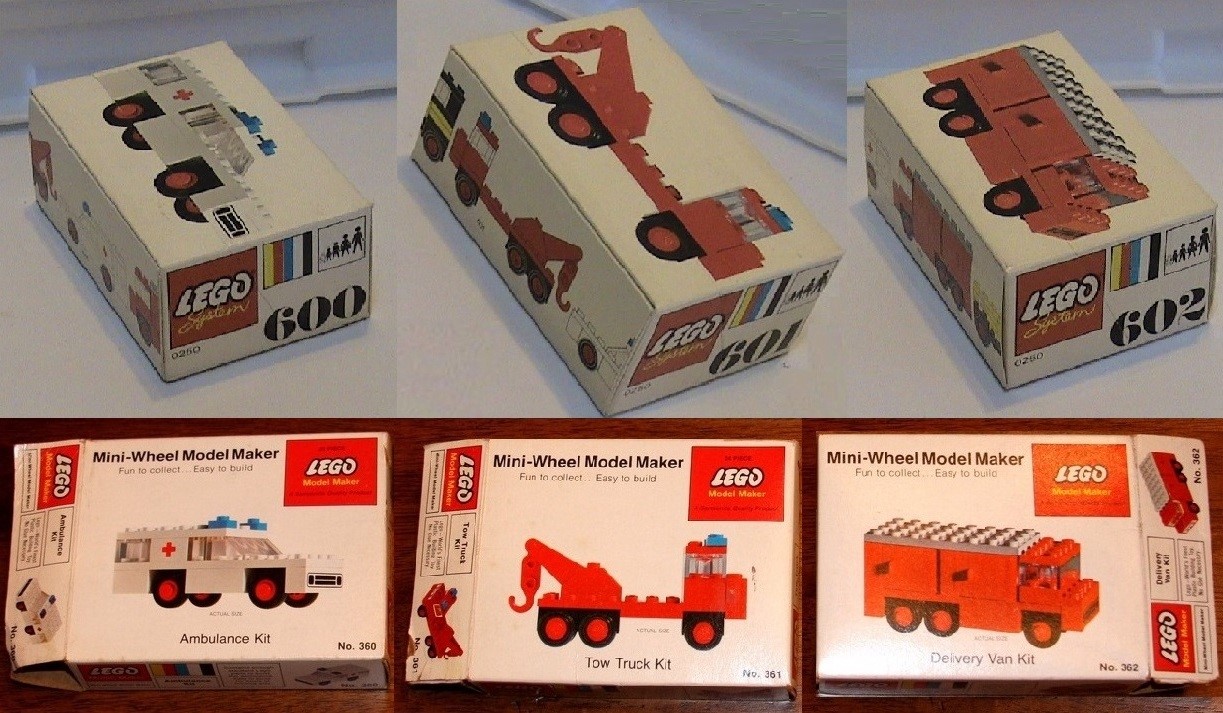
Here we see three different LEGO models, the Ambulance Set (360 in USA, 600 elsewhere), the Tow Truck Set (361 in USA, 601 elsewhere), the Delivery Van Set (362 in USA, 602 elsewhere). These sets show the different layout and English text (Model Makers) on the USA Samsonite sets, and the layout and lack of text on the continental European version. The British version now looked very much like the continental European boxes, but the Canadian boxes were still showing English/French text (Model Makers), but European set numbers. The 1970s were a confusing time for LEGO sets!
By 1973 the USA sets were produced by TLG, and in 1974 production started in Enfield Connecticut. The different set numbers continued, but the boxes looked much more like their European counterparts, but still bearing English text and set part counts. Canadian sets continued to be made by Samsonite, and were still bilingual on the box tops, and also included part counts. British LEGO Ltd. continued producing (nearly) identical sets to those of continental Europe.
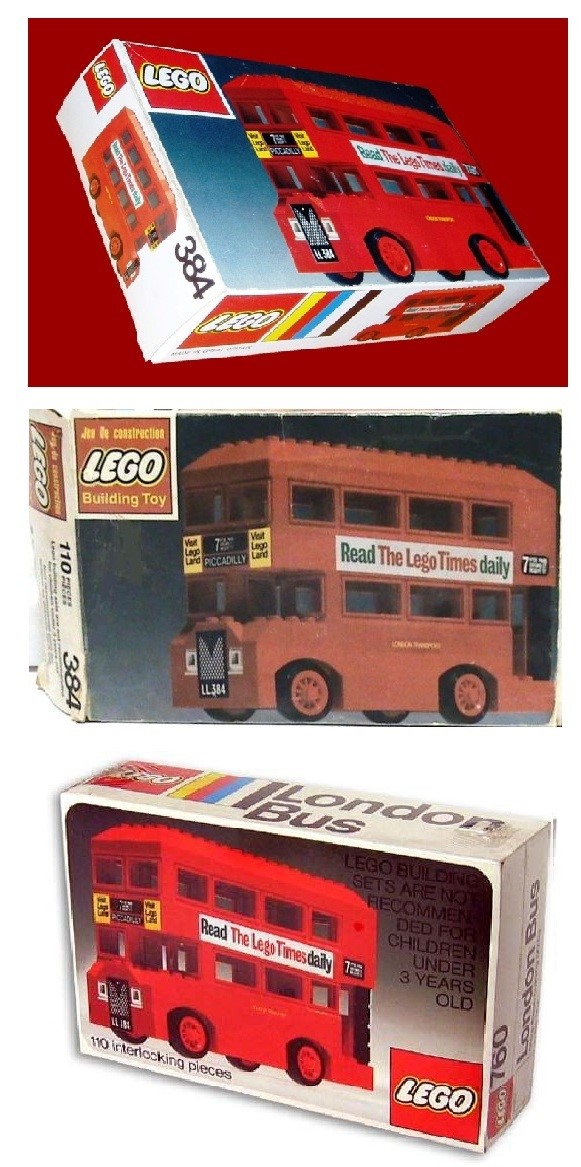 Here we see three different LEGO box variations, and two different set numbers for the one same model. The London Bus Set was introduced in Europe and Australia in 1973 as set 384 (top). Two years later (1975) this 384 London Bus Set was introduced in Canada (middle) with English/French text. Also introduced in 1975 was the USA London Bus Set, but under the 760 number, and with English text. Both the Canada and USA sets had the parts count listed on the box.
Here we see three different LEGO box variations, and two different set numbers for the one same model. The London Bus Set was introduced in Europe and Australia in 1973 as set 384 (top). Two years later (1975) this 384 London Bus Set was introduced in Canada (middle) with English/French text. Also introduced in 1975 was the USA London Bus Set, but under the 760 number, and with English text. Both the Canada and USA sets had the parts count listed on the box.
The three types of LEGO boxes with two set numbers for one model continued on until 1980, when all countries changed to common 4-digit set numbers (still 3-digits for basic and some parts pack sets). The three box types continued however, but under the same set numbers.

Here again we see three different LEGO box variations, and two different set numbers for the one same model. The 857 Motorcycle Set was introduced in 1979 in Europe (upper left), and also in bilingual Canada (lower left). The following year (1980) when 4-digit set numbers were introduced, the 8857 Motorcycle set was introduced in the USA. Here we see another anomaly between different technical LEGO related sets of that era. In Europe/Australia and Canada these new (1977 introduced) sets were called the TECHNIC sets. However, in the USA the term EXPERT BUILDER was used. This different naming convention continued on until the mid 1980s, when TECHNIC became the universal name for these technical sets. Note also the upper left set has a sticker, in Italian. It was common for many European LEGO sets of that era to have a local language sticker on the boxes.
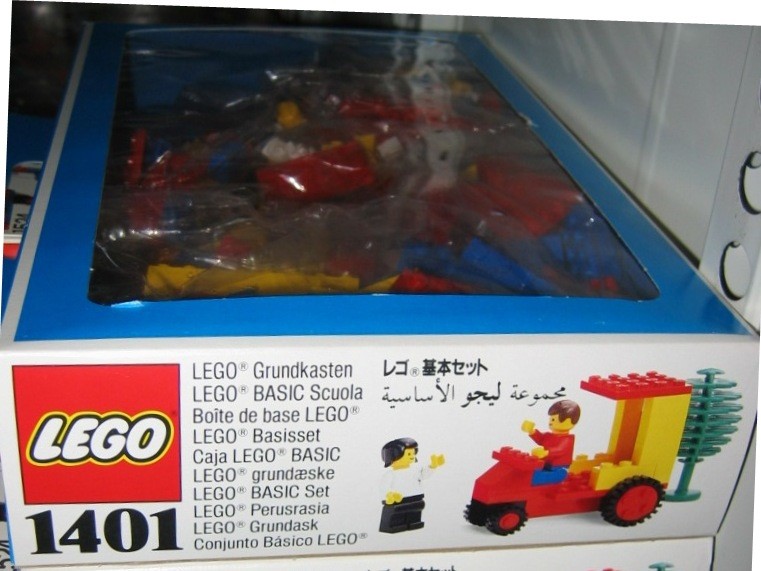
Here we see a never released 1401 DACTA LEGO set showing writing in 12 languages on the box.
In the 1970s and 1980s in Europe there is a large variation in what is written on LEGO set boxes. Sometimes there will be writing in up to 12 languages (less for smaller box sizes), and other times there will see no writing on the boxes at all. There was no set pattern in what TLG did for producing boxes with or without writing, although small LEGO boxes were usually with writing.
When the gray track 12V Train System sets were introduced in 1980 in continental Europe, they were also introduced in Britain, Ireland and Australia, but not USA or Canada. These trains were found with spare parts packs with 9-12 languages on the boxes, ditto for some of the larger ancillary sets, such as rail crossings. However, the locomotive and complete train sets took a step back in time to the 1950s. These larger sets had boxes in the local languages once again. These sets came out in three versions, with three languages each. There were the German-Dutch-French box type (for Germany, Austria, Luxembourg, Netherlands, Belgium, Switzerland) the English-Italian-French box type (UK, Ireland, Australia, Italy, France), and the Danish-Swedish-Finnish box type (Denmark, Sweden, Finland). These “regional” boxes were not found generally in other LEGO Systems, and in the early 1990s the 12V Train System sets were discontinued.
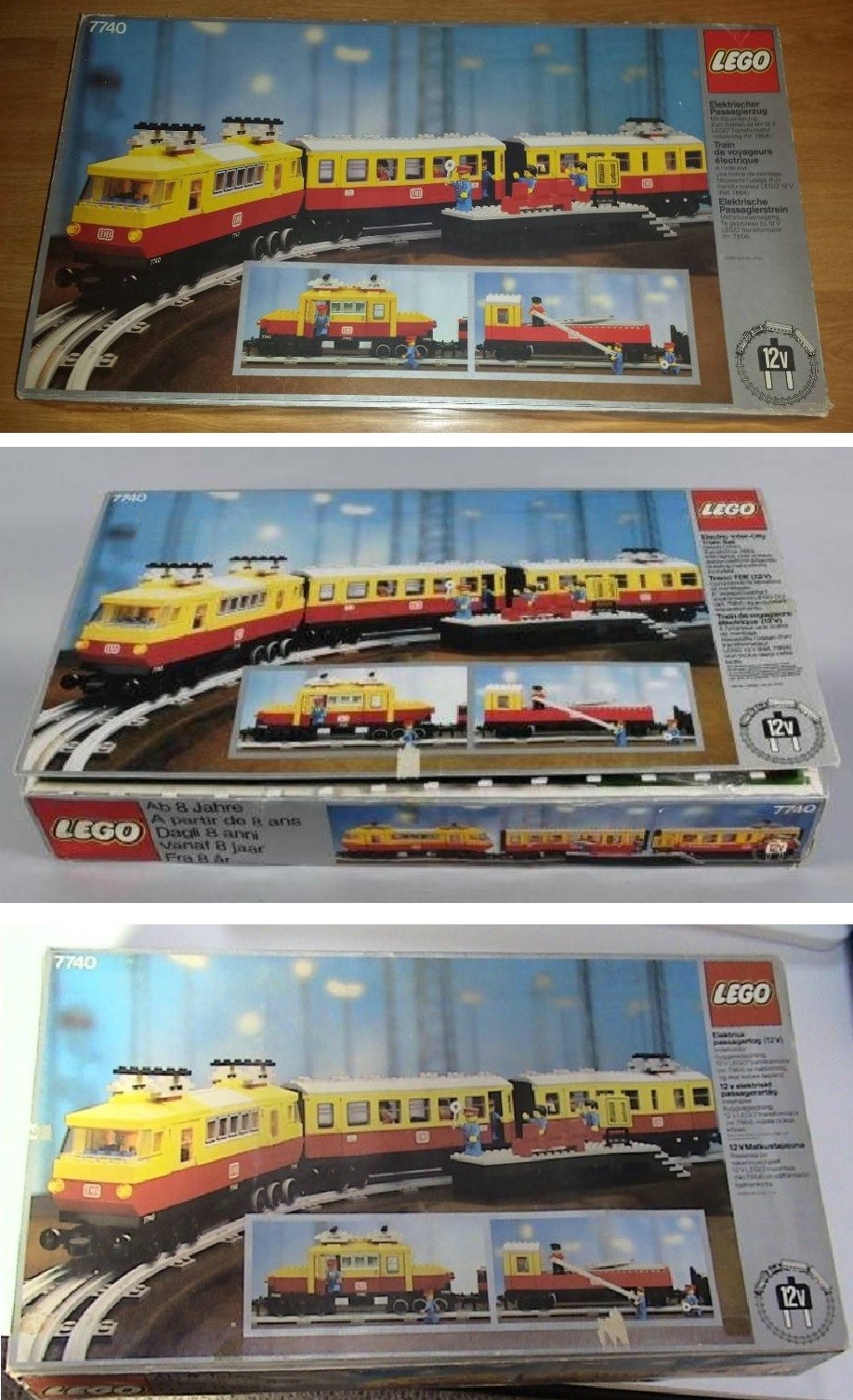 Here we have the 12V 7740 Intercity Train set of 1980. This set came in a DE-NL-FR language box type (top), also in a EN-IT-FR language box type (middle), and also in a DK-SE-FI language box type (bottom).
Here we have the 12V 7740 Intercity Train set of 1980. This set came in a DE-NL-FR language box type (top), also in a EN-IT-FR language box type (middle), and also in a DK-SE-FI language box type (bottom).
In 1985 TLG bought the Canadian LEGO license back from the Wall Street brokerage firm that split up the multi-national corporation that had purchased Samsonite in 1973. However the Stratford Ontario LEGO plant continued to produce bilingual LEGO sets until production was transferred to Enfield Connecticut in 1990. Then in 1992 the license for LEGO production in Britain, Ireland and Australia was purchased back from the Courtauld’s Corporation (owner of British LEGO Ltd.), and LEGO production switched from Wrexham Wales to Billund Denmark. So by 1993, LEGO boxes, produced either in Billund or Enfield, were now becoming more unified in their design than ever before.
Part 3 of this article covering the period 1992-present will follow shortly...
--
Gary Istok is a world renown expert on LEGO who has published a 2000-page LEGO Collectors' guide, which can be purchased and downloaded from here. You can also download a sample chapter.
0 likes
4 comments on this article
It's interesting that LEGO produced such sets for all over the world and in different languages. Thanks to LEGO pushing into USA and other parts of the world and making this hobby a truly world-wide phenomenon... Still going strong after all these years.
There is an extended version of this discussion in the Brickset forums. Glad to share info about old and new LEGO sets...
http://www.bricksetforum.com/discussion/17761/lego-set-box-variations-for-eu-uk-aus-usa-can-and-why-some-are-worth-more-than-otherslatest
I LOVE this kind of historic LEGO information!
Very interesting, I love this kind of thing and look forward to reading further articles from Gary.